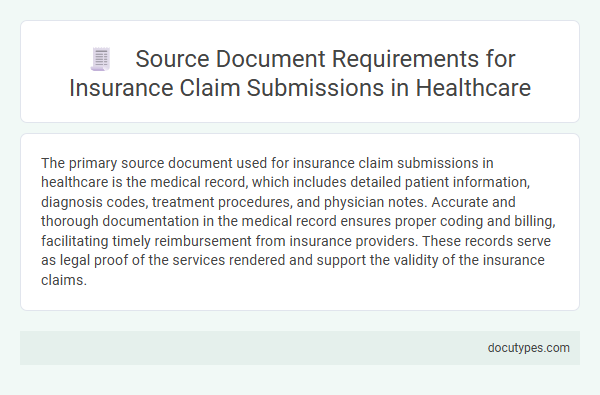The primary source document used for insurance claim submissions in healthcare is the medical record, which includes detailed patient information, diagnosis codes, treatment procedures, and physician notes. Accurate and thorough documentation in the medical record ensures proper coding and billing, facilitating timely reimbursement from insurance providers. These records serve as legal proof of the services rendered and support the validity of the insurance claims.
Introduction to Source Document Requirements
Source documents are essential for accurate insurance claim submissions in healthcare. These documents provide verified clinical information that supports billing and reimbursement processes.
- Medical Records - Comprehensive patient charts detailing diagnoses, treatments, and outcomes used to validate claims.
- Physician's Notes - Detailed records from healthcare providers outlining clinical observations and prescribed care.
- Test Results - Laboratory and diagnostic reports that confirm medical necessity for services rendered.
Importance of Accurate Documentation in Insurance Claims
Source documents such as medical records, physician notes, and diagnostic reports form the foundation for insurance claim submissions in healthcare. Accurate documentation in these sources ensures proper billing and reduces the risk of claim denials or delays.
- Medical Records - Comprehensive patient histories and treatment details validate the services provided to support claim authenticity.
- Physician Notes - Detailed physician observations and diagnoses provide crucial evidence required by insurers for claim approval.
- Diagnostic Reports - Results from lab tests and imaging studies confirm the necessity of treatments and procedures billed.
Precision in documenting patient information directly impacts reimbursement accuracy and compliance with insurance policies.
Key Source Documents for Healthcare Claims
In healthcare, the primary source document used for insurance claim submissions is the medical record. This document contains detailed patient information, treatment history, and clinical notes essential for accurate claim processing.
Other key source documents include the physician's progress notes, operative reports, and diagnostic test results. These documents provide necessary verification of services rendered and support the billing codes submitted to insurance providers.
Patient Identification and Verification Records
| Source Document for Insurance Claim Submissions | Patient Identification and Verification Records |
|---|---|
| Definition | Documents that confirm the patient's identity and eligibility for insurance coverage prior to medical service billing. |
| Key Components |
|
| Purpose in Claims Process | Ensures accurate patient identification, verifies insurance coverage, and prevents claim denials caused by mismatched or incomplete information. |
| Common Forms Used |
|
| Impact on Reimbursement | Accurate patient verification reduces claim rejections, minimizes processing delays, and supports timely reimbursement from payers. |
Medical Provider Documentation Standards
Medical provider documentation serves as the primary source document used for insurance claim submissions in healthcare. This documentation includes detailed patient records such as clinical notes, diagnostic test results, and treatment plans that validate the services rendered.
Accurate and comprehensive medical provider documentation adheres to regulatory and payer-specific standards to ensure claim approval. It plays a critical role in demonstrating medical necessity, supporting billing codes, and preventing claim denials or audits. Healthcare providers must maintain clear, timely, and precise documentation to comply with insurance requirements and facilitate efficient reimbursement processes.
Clinical Notes and Treatment Records
The primary source document used for insurance claim submissions in healthcare is the clinical notes and treatment records. These documents provide detailed information on patient diagnosis, treatment procedures, and healthcare services rendered. Your accurate and thorough clinical documentation ensures proper claim processing and reimbursement from insurance providers.
Diagnostic Test Reports and Imaging Results
Insurance claim submissions in healthcare primarily rely on source documents such as diagnostic test reports and imaging results. These documents provide detailed information about the patient's condition, test findings, and medical necessity, which are essential for accurate claim processing. Proper documentation from diagnostic labs and imaging centers ensures compliance with payer requirements and supports reimbursement efforts.
Insurance Policy and Authorization Documentation
What source document is used for insurance claim submissions in healthcare? The primary source document for these submissions is the insurance policy and authorization documentation. Your insurance policy outlines coverage details, while authorization documentation verifies pre-approval for specific medical services, ensuring claims are processed accurately.
Common Documentation Errors and Compliance Risks
Source documents such as patient records, physician notes, and diagnostic reports form the basis for insurance claim submissions in healthcare. Accurate and complete documentation is critical to avoid common errors and comply with regulatory standards.
- Incomplete Documentation - Missing or vague information in source documents often leads to claim denials and payment delays.
- Incorrect Coding - Errors in translating clinical data into billing codes increase the risk of compliance violations and audits.
- Noncompliance with Regulations - Failure to adhere to payer-specific or HIPAA requirements in documentation exposes providers to legal and financial penalties.
What Source Document Is Used for Insurance Claim Submissions in Healthcare? Infographic

